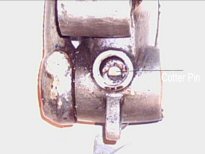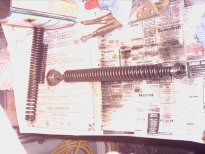Front
suspension ~ currently in the process of dismantling.
I have removed one link arm for re-chroming and just need
to press the  other
cotter pin out to remove the second one. The first one
came out quite easily using a drift and a hammer and a
few minutes with a paint stripping heat gun. However the
second one will not move al all. You can see the location
clearly if you click on the diagram on the left to see it
in full size.
other
cotter pin out to remove the second one. The first one
came out quite easily using a drift and a hammer and a
few minutes with a paint stripping heat gun. However the
second one will not move al all. You can see the location
clearly if you click on the diagram on the left to see it
in full size.
 The pin is quite solid and I think
it will need the controlled force of a hydraulic press in
order to move it safely and without damage to either the
pin or any other parts of the suspension system
The pin is quite solid and I think
it will need the controlled force of a hydraulic press in
order to move it safely and without damage to either the
pin or any other parts of the suspension system
The cotter pin is removed by pressing it out, downwards
from the oil filler hole out through the bottom of the
forks, once the end cap has been removed. The second
cotter pin was removed with the help of a neighbour and a
very robust vice. The whole assembly was mounted in the
vice, with a drift pressing down on the pin (held by the
front vice jaw) and an old socket held by the rear vice
jaw behind the pin. Once we had applied plenty of force
with the vice's Tommy bar, we shocked the vice using a
lump hammer hitting the front vice jaw whilst heating
with the paint stripper gun. This loosened the pin enough
to be able to drift it out easily. However you WILL need
a very robust vice for this.
The link arm
can be removed by separating it from the link piece that
connects the arm to the hydraulic damping piston. Each
piston has an O-Ring oil seal (external diameter ~ 33mm
and internal diameter 25mm) which is shown as a
"gasket" on the above diagram and these are
best replaced. They are available from Sally at
Manchester Seals in Salford, Manchester ~ Tel 0161 832
7922) and cost pennies.
Likewise the link arms also have one oil seal each which
are 22mm x 32mm x 7mm rotary shaft oil seals and are also
available from the same supplier for approximately £4
each (15th June 2005).
 As you can see from this image,
springing is provided by two springs, held in place at
the top with a screw cap
As you can see from this image,
springing is provided by two springs, held in place at
the top with a screw cap
(these can be accesses once the
chrome fork shroud has been removed), that can be removed
once the lower
alloy end caps have been removed and the
oil drained out (more info on oil and dampening to
follow).
I used a
drift to tap the screw caps anti-clockwise and loosen the
thread, then they came off by unscrewing by hand.
This information from Phil Speakman's
UK Adler site.
An Auzzie article is planned for the next CD.
 The pin is quite solid and I think
it will need the controlled force of a hydraulic press in
order to move it safely and without damage to either the
pin or any other parts of the suspension system
The pin is quite solid and I think
it will need the controlled force of a hydraulic press in
order to move it safely and without damage to either the
pin or any other parts of the suspension system other
cotter pin out to remove the second one. The first one
came out quite easily using a drift and a hammer and a
few minutes with a paint stripping heat gun. However the
second one will not move al all. You can see the location
clearly if you click on the diagram on the left to see it
in full size.
other
cotter pin out to remove the second one. The first one
came out quite easily using a drift and a hammer and a
few minutes with a paint stripping heat gun. However the
second one will not move al all. You can see the location
clearly if you click on the diagram on the left to see it
in full size.
